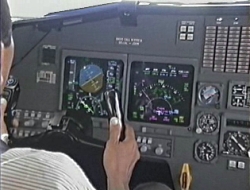The Flare. The flare reduces the
approach rate of descent to a more acceptable rate for touchdown. If the flare
is extended while additional speed is bled off, additional runway will be used.
An extended flare may also result in an increase in pitch attitude which may
lead to a tail strike. A firm landing does not mean a hard landing, but rather
a deliberate or positive touchdown at the desired touchdown point. A landing
executed solely for passenger comfort considerations, which extends the
touchdown point beyond the TDZ, is not impressive, desirable, or consistent
with safety or regulations. It is essential to fly the airplane onto the runway
at the target touchdown point. Effects of an Extended Flare, as
an example of the results of an extended flare.
(3) Be conservative and add 20
percent to the rollout distance if the pilot does not maintain maximum braking
until the airplane reaches a full stop. Otherwise, if available, use AFM data
for less than maximum braking.
(4) For airplanes that do not have antiskid
brakes, spoilers, or thrust reverse, caution should be exercised. Excessive
braking can lead to causing a tire failure or cause a skidding condition,
leading to a runway excursion. Therefore, flying a stabilized approach and
timely application of deceleration devices are the keys to a safe landing.
NOTE: Example: Available runway 5,
000 feet (ft), AFM landing distance 3,000 ft, at correct speed, and at 50-ft
TCH, a total of 3 seconds to deploy the airplane’s deceleration devices,
results in 1 second over the AFM landing distance assumed 2 seconds to deploy
deceleration device will result in an additional 200 ft operational landing
distance, for a total of 3,200 ft.
i. Landing with a Tailwind – Effect
of a Tailwind on Landing Distance. The effect of a tailwind on landing distance
is significant and is a factor in determining the landing distance required.
Given the airplane will land at a particular airspeed, independent of the wind,
the principal effect of a tailwind on operational landing distance is the
change in the ground speed at which the airplane touches down.
(1) The effect of a tailwind will
increase the landing distance by 21 percent for the first 10 kts of tailwind.
(Refer to the Pilot’s Handbook of Aeronautical Knowledge, and the aircraft’sAFM/POH
data to determine if tailwind landing data is available for the airplane.)
Aiming Point. The aiming point is
the point on the ground at which, if the airplane maintains a constant
glidepath and does not execute the round out (flare) maneuver for landing, it
would touch the ground.
Mitigating the Risks of a Runway
Overrun Upon Landing
This guidance pertains to the
preflight planning requirements of Title 14 of the Code of Federal Regulations
(14 CFR) part 91, §§ 91.103, 91.1037, and 91.605; part 121, § 121.195; and part
135, § 135.385.
The Effect of Excess Airspeed. The
pilot must be aware of airspeed during the approach and of the targeted
reference landing airspeed (VREF)/airspeed, plus wind gust adjustments, over
the runway threshold. An excessive approach speed may result in an excessive speed
over the runway’s threshold, which may result in landing beyond the intended
touchdown point as well as a higher speed from which the pilot must bring the
airplane to a stop. (Refer to the current editions of FSF ALAR Briefing Note
8.3—Landing Distances, and Boeing’s Takeoff/Landing on Wet and Contaminated
Runways.)
Landing Beyond the Intended
Touchdown Point. AFM/POH distances are based on a touchdown point determined
through flight-testing procedures outlined in the current editions of AC 25-7
and AC 23-8. If the airplane does not touch down within the air distance
included in the AFM or POH landing distance, it will not be possible to achieve
the calculated landing distance.
f. Downhill Runway Slope. A negative
runway slope of 1 percent (downhill) increases landing distance by 10 percent
(a factor of 1.1). (Refer to FSF ALAR Briefing Note 8.3 and Appendix 1, Table
1-3, Sample Computation: Runway Length 7,000 ft.)
g. Excessive Height Over the Runway
Threshold – Threshold Crossing Height (TCH) Greater Than 50 ft (Excess TCH).
The certified landing distances furnished in the AFM are based on the landing
gear being at a height of 50 ft over the runway threshold. For every 10 ft
above the standard 50 ft threshold height, landing air distance will increase
200 ft.
NOTE: For example, TCH of 100 ft
increases the landing distance by about 1,000 ft (50 additional ft divided by
10 = 5 X 200 ft landing distance increase per each 10 ft above 50 ft TCH =
1,000 ft additional landing distance). (Refer to FSF ALAR Briefing Note 8.3.).
THE EFFECTS OF COMPOUND FACTORS—THE END IS CLOSER THAN YOU THINK
Touchdown Point. Extended flare and
runway slope are two factors that affect pilot control of the touchdown point.
Turbine airplanes should be flown onto the runway rather than being held off
the surface as speed dissipates. A firm landing is both normal and desirable.
The typical operational touchdown point is in the first third of the runway,
and it may be farther down the runway than the 1,000 ft point. This additional
distance should be accounted for in the landing distance assessment at time of
arrival (TOA).
NOTE: A 10 percent excess landing speed causes at least a 21 percent increase in landing distance. The excess speed places a greater working load on the brakes because of the additional kinetic energy to be dissipated. Also, the additional speed causes increased drag and lift in the normal ground attitude, and the increased lift reduces the normal force on the braking surfaces. The deceleration may suffer during this range of speed immediately after touchdown, and it is more probable for a tire to be blown out from braking at this point.
EFFECT OF WIND ON LANDING PERFORMANCE
Critical Condition Combinations. The
most critical conditions of landing performance are combinations of:
• High gross weight, high density
altitude,
• Wet/contaminated runway,
• Tailwind landing,
• Downhill slope,
• Less than maximum landing flap,
and
• Short runway.
NOTE: In all cases, it is necessary
to make an accurate prediction of minimum landing distance to compare with the
available runway.















